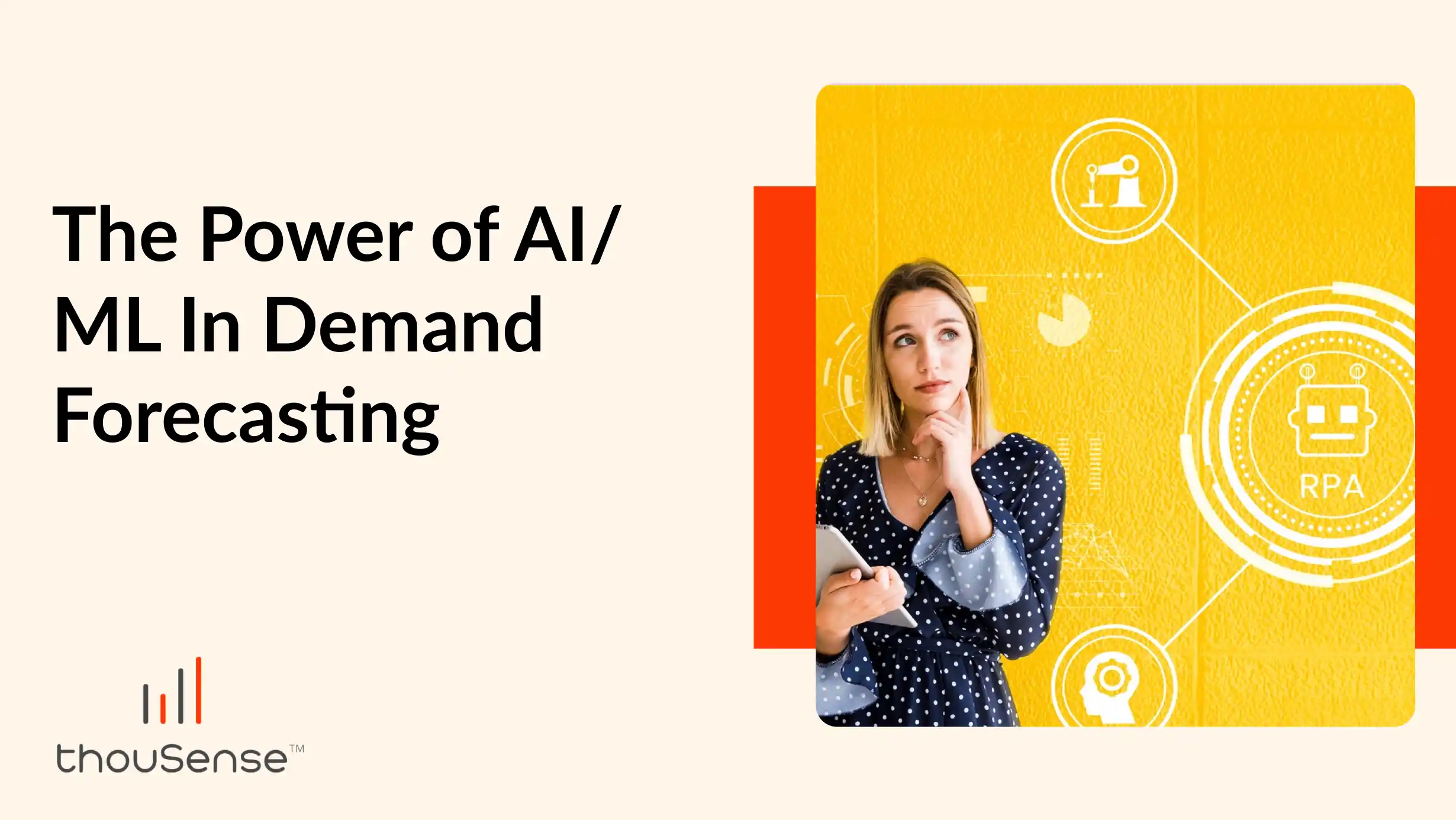The Power of AI/ML In Demand Forecasting
ML forecasting in demand helps analyse data, predict future behaviour, and make predictions.

An Introduction to Demand Forecasting
Demand forecasting is an estimation of the demand that will occur in the future for a product or service. The forecasting process involves analysing the past demand for a product or service in the market today and comparing it to what was there back then.
Companies have been doing demand forecasting since time immemorial, whether using scientific/statistical methods or Rules of Thumb. While these methods are robust and time-tested for long-term forecasts, they don’t really augur well for short-term demand reshaping. Short-term fluctuations in the ecosystem whether upstream or downstream can throw the demand estimations off gear. If we monetize, the losses on account of short-term horizon inaccuracies, on account of inventory pile up at the depots or lack of inventory and the service levels lost on account of both, we are staring at leakages amounting to thousands to sometimes millions of dollars.
Imagine, however, the ability to have an algorithm that adapts in real-time to the needs of your customers. Here is where AL/ML demand forecasting comes to the rescue.
Artificial Intelligence and Machine Learning are changing the world of Demand Forecasting for businesses globally. Let's look at Demand Prediction and Demand Planning to see how AI forecasts in-demand works.
Demand Prediction- Demand Planning and Forecasting
Demand planning and Forecasting are critical parts of business development, whether one is planning for growth or demand. Demand planning and Forecasting is a genius way to prepare for how much inventory one needs.
To ensure that prediction algorithms yield accurate insights, companies must select methods and proper demand planning and forecasting solutions appropriate for their circumstances. Changes in economic conditions and long-term changes in customer behaviours can make Forecasting tricky.
Intelligent Demand Forecasting Techniques
Businesses can improve forecast accuracy and optimise replenishment plans by implementing AI Demand Forecasting techniques into supply chain management.
ML Demand Forecasting is more accurate and reliable. In contrast to humans, AI demand forecasting does not have such a downside as mistakes while analysing data. The demand prediction is fully unbiased once it is created by machine learning.
As stated by machine acquiring, posing a question to the planning entity allows for the automation of modifications. One does not have to develop new forecasts every week because the exemplar will do it all for you based on the most relevant data. Furthermore, machine acquisition ensures significantly faster information processing, which is critical in some situations.
Demand generation tool sets with advanced machine learning may not only help marketers better understand demand but may also make their business more profitable over time. As a result, companies can improve their demand forecast with minimal risk by using ML to analyse data and patterns to predict future demand with uncanny accuracy.
For decades, sales leaders have used data science techniques to automate B2B sales. The latest demand forecasting techniques and AI software solutions can now measure customers' intent and use that information to predict which products will win and which will lose. Thanks to a better understanding of demand planning and demand prediction, one can now know how to measure demand. Cognitive insights are now becoming quantifiable, and data science is being mainstreamed to predict an organisation's future.
Demand forecasting techniques using AI/ML are beneficial for retailers in myriad ways:
● Retailers can identify their target audience and anticipate their sales.
● Retailers need to discover their target audiences, their interests, and their demographics.
● It helps retailers analyse the size, performance, and competition of their target audiences.
Frequent inventory monitors and keeps track of the products that are not selling well, leading to higher storage costs, reflecting how demand and sales can fluctuate depending on the season.
Business Forecasting
Business forecasting is a vital part of corporate planning, whether for growth or demand. Many companies have used traditional statistical techniques like univariate and multivariate models. Still, in today's world, these models can't handle the number of business metrics and KPIs available to companies for Forecasting.
An AI-based solution can provide significantly more accurate forecasts by analysing as many available factors as possible by identifying patterns and correlations that would otherwise go unnoticed. Artificial intelligence-based solutions and demand prediction can incorporate all of these factors and require little user input, improving the business forecasting experience.
AI-powered forecasting demand techniques and business forecasting solutions can cover the entire pipeline starting from data pre-processing to consuming the insights, just by considering the metrics, the time horizon, and desired forecast. Furthermore, the fact that AI-driven business forecasting is more accurate regardless of the industry or the KPI is understood by many companies.
The power of AI/ML Demand Forecasting- How AI can help your business skyrocket to elevated revenue heights
The power of AI/ML demand forecasting is changing the forecasting game, making it easier for businesses to predict demand. As a result, AI demand forecasting is being heavily invested by companies to reduce modelling costs, improve accuracy, and deliver dynamic supply-demand balance.
Due to the increase in data generated by businesses and external sources, traditional forecasting methods cannot deal with the current data and AI Forecasting has been preferred widely.
| Traditional Forecasting | AI/ML Forecasting |
|---|---|
| Low Accuracy Level | High Accuracy Level |
| Can't Manage Data in a Large Amount | Deals with Bigger Data |
| Less Effective | Self-Correcting and Powerful |
| Upredictable Forecast | Well Combined Forecast |
ML forecasting in demand helps analyse data, predict future behaviour, and make predictions. With the future of machine learning comes predictions, not just models, which will lead to powerful sales tools and decision-making frameworks that combine human intelligence and machine learning technologies.
With AI demand and business forecasting, companies can process data much faster than traditional forecasting frameworks and humans. A predictive analytics system can also illuminate internal or supply chain problems humans may miss and create accurate forecasts that help companies make wiser decisions.
New and growing companies must decide when to ramp up production since it is one of the most significant decisions they have to make. Even though monthly revenue may appear promising, scaling a company requires additional investment and increased staffing. Artificial intelligence can forecast the company's growth using historical data to develop a more accurate picture of its current growth and predictions for the upcoming year.
Artificial intelligence can investigate the company's sales in multiple ways. For example, suppose a business makes about 10,000 product sales per month, growing by about 20% every month; with AI demand forecasting, companies can quickly determine how much growth they
will experience over the next year and forecast growth numbers, such as how much inventory they should have to meet demand and when to hire additional operational or supply chain staff.
Demand forecasting is the most widely used machine learning application in supply chain planning. More and more companies are planning to implement AI-powered Forecasting of demand due to its rapid growth, intelligence and accuracy.
With ML, AI Forecasting can take a business to the next level. One can create more accurate forecasts based on internal and external signals, such as demographics, weather, online reviews, and social media. Supply chain networks that use external data and modern machine learning algorithms can outperform those managed more manually by data analysts and embrace changes in the environment.
Demand Forecasting is now being integrated into the operations of leading brands like Walmart and Starbucks. The power of ML/AI Demand Forecasting has disrupted the world of Forecasting by using intelligent techniques and is all set to transform businesses with the power of technology emphatically.
